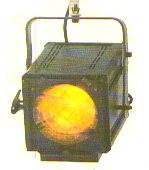If you think of electricity (a flow of current through a wire) in terms of a water flow through a pipe, then voltage is the pressure of the pump driving the water through the pipe, current is the amount of water flowing and power is a measure of the work the water is able to do when it turns a turbine.
Power is voltage x current and is measured in Watts. Voltage is measured in Volts, and Current is measured in Amps.
Each lantern has a power rating in Watts (abbreviated to W).

 For example, a Selecon Acclaim Fresnel (shown left) is 650W and a Strand Cantata Fresnel (shown on the right) is 1200W.
For example, a Selecon Acclaim Fresnel (shown left) is 650W and a Strand Cantata Fresnel (shown on the right) is 1200W.
The wattage refers to the amount of electricity needed to make the lamp light. A brighter lamp needs more electricity.
Therefore, the Acclaim Fresnel has a lower power requirement (wattage) than the Cantata Fresnel.
1000W = 1kW = 1 kilowatt
Why do I need to know this?
This is important information because the electrical supply into the building where you’re using the lighting is limited, as is the power capability of the dimmers you’re using.
Most dimmers in the UK are each rated at 10 Amps. This means that they can provide 10 Amps of electrical current before they overload and cause the fuse to blow.
It is difficult to see the link between Amps anything else until you see the following equation:
Power (Watts) = Voltage (Volts) x Current (Amps)
or…Current (Amps) = Power (Watts) / Voltage (volts)
This equation is known in the USA as the West Virginia formula (W=VA)
This equation is derived from one known as Ohm’s Law, which relates Voltage, Current and electrical Resistance (V = I x R or Volts = Current x Resistance)
Examples
Taking the Acclaim Fresnel as an example;
Power = 650W
Voltage = 230V (this is more or less standard throughout Europe)
so Current = 650W / 230V = 2.8 Amps.
This means that you could plug an Acclaim Fresnel into a 10 Amp dimmer and still have just over 7 Amps left to play with before the dimmer became overloaded and blew a fuse.
Using another example, the Strand Harmony Fresnel has a 1000W lamp;
Current = 1000W / 230V = 4.3 Amps.
Therefore, the Harmony Fresnel is using just under half the dimmers’ rated capacity of 10 Amps. This means that you could safely plug two of these 1000W lanterns into one dimmer without blowing the fuse.
Please note: it may be easier for you to remember that a 10A dimmer has a potential load of 230V x 10A = 2300W. As long as you keep under that wattage, you won’t overload it.
Fuses
 As an example, the Zero 88 Chilli Pro dimmer racks shown on the right here contain twenty-four dimmers. Each dimmer has a MCB (miniature circuit breaker) protecting it, which is located in a panel at the right hand side of the dimmer rack. Each circuit breaker is rated at 10 Amps.
As an example, the Zero 88 Chilli Pro dimmer racks shown on the right here contain twenty-four dimmers. Each dimmer has a MCB (miniature circuit breaker) protecting it, which is located in a panel at the right hand side of the dimmer rack. Each circuit breaker is rated at 10 Amps.
Any current over that level will cause the breaker to trip so that the dimmer circuitry and cabling doesn’t get damaged. The dimmers are arranged so that the breaker on an individual circuit will blow before a circuit breaker trips on a whole dimmer rack. If a lamp blows on the rig, chances are that it will take out the dimmer circuit breaker when it blows. There is a high current briefly before the lamp expires which is sufficient to blow the fuse. It also follows that if a fuse has gone, its probable that the cause of that is the lamp blowing.
If a fuse keeps blowing for no apparent reason, seek help – don’t keep replacing it.
Remember :
Current (Amps) = Power (Watts) divided by Voltage (volts)
At 230 Volts, the maximum load on each 10A dimmer is 2300W and 1000W = 4.35A
(NB: The above figures apply in the UK and Europe – the USA uses 120 Volts)
Author credit: Jon Primrose, Theatrecrafts.com, Last updated December 2017
Keywords: Power Overload, Fuse Blowing, Electrical Safety, Blowing A Fuse
